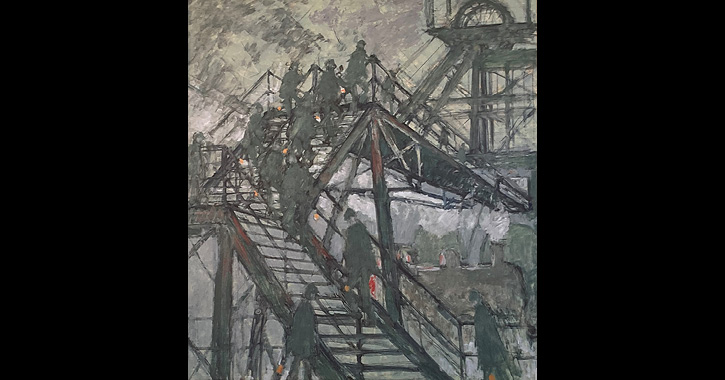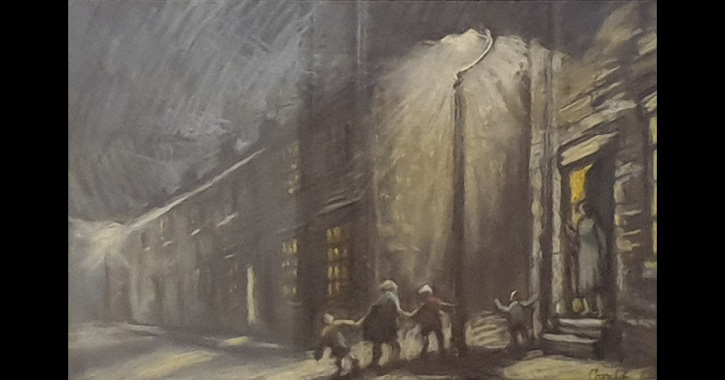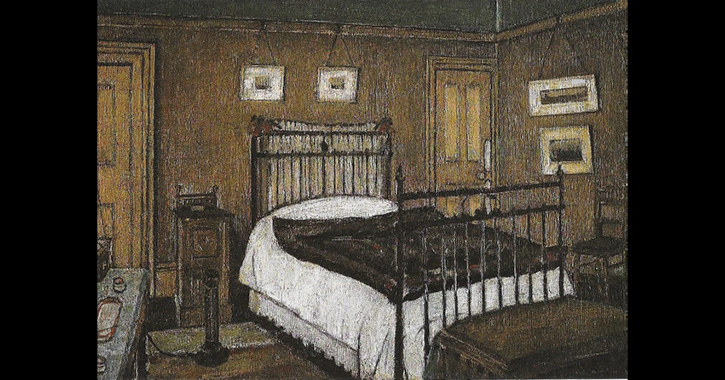Did you know any of these facinating facts about Norman Cornish and L S Lowry?
Read the blog below and find out more about these incredible artists ahead of: Norman Cornish and LS Lowry: Kith and Kinship, opening at The Bowes Museum from 20 July 2024 until 19 January 2025.
.jpg)
Laurence Stephen Lowry was born on the 1 November 1887 in Barrett Street in Old Trafford, Manchester. Norman Stansfield Cornish was born on November 18 1919, in Catherine Street in Spennymoor, Durham. A chronological gap of thirty two years, but a much wider gulf in terms of their local environment and the socio-economic circumstances in which they both spent most of their early years growing up and as aspiring artists.
Lowry’s family has been described as ‘lower middle class’ with parents who had high ambitions. The Cornish family was firmly rooted in working class culture with an underlying basic need to survive ‘hard times.’ Lowry lived for 88 years until 1976 and Cornish ‘passed away’ in 2014 at the age of 95.
Cornish lived in a house with no bathroom or inside toilet, where he shared a room with his five brothers and one sister. He described living conditions as ‘primitive’ and he contracted diphtheria when seven years old. The only reading material at home was an American detective comic.
His journey from miner, to professional artist, is a story of determination and resilience to overcome hardship and prejudice.
Cornish started work aged 14yrs on Boxing Day 1933 at Dean & Chapter Colliery. He walked three miles to work in the snow to start as a Pony Putter. He was denied the opportunity of continuing his education like so many others at this time.

Pit Gantry Steps by Norman Cornish, circa 1967
In his early years Lowry suffered repression from his mother, an accomplished pianist, who was disappointed when he was born, hoping for a girl. She was also frustrated that he didn’t share her aspirations for a traditional academic route to future employment in view of the investment his parents had made for Lowry to attend a private school. Lowry’s emerging interest in drawing was met with chagrin within the family circle although he was determined to fulfil his interest in drawing and painting.
Lowry attended three different art schools in between working as a rent collector. He experimented with his figures and was advised to use a white background to make buildings and people ‘stand out.’ He developed a characteristic style to suit the industrial and city subjects that he generally painted with a limited palette of five colours: ivory black, vermillion, Prussian Blue, yellow ochre and flake white. According to Lowry he generally ‘invented the figures’ in his pictures.
Cornish was initially turned away from The Spennymoor Settlement Sketching Club because he was too young. He eventually joined and was influenced by the advice to ‘paint the things around you.’ He was denied an opportunity to attend The Slade School of Art because it was 1939 and he was in a reserved occupation and had to continue working as a miner. The members of the Sketching Club were gifted a set of oil paints by Mrs Baker- Baker of Ellemore Hall and Cornish also used pastels, watercolours and the Flo-master pen in his drawings as his career developed. Cornish’s sketchbooks contain hundreds of observations of people in different settings who often appear later in different compositions.

Bishops Close Street at Night by Norman Cornish, 1961
In 1930 Lowry staged a solo exhibition of drawings at The Roundhouse, Manchester University Settlement, which was also part of the national Settlement movement.
Both artists were influenced by their immediate environments. One day in 1916 Lowry missed his train to art school but the view from the station steps became a significant moment when he saw the yellow lights from the Acme Mills. His vision to paint the industrial scene was born and he claimed ‘nobody had done it,’ although this was not entirely correct.
For the first thirty years of his life his work was ignored and in his twenties when he painted some of his most famous pictures he was often ridiculed as a ‘Sunday painter.’ He didn’t sell much of his work.
Cornish retired from mining in 1966 after working for 33 years underground whilst continuing to draw and paint. It was inevitable that his working environment impacted his work and the interpretation of his experiences. He later worked part time as a lecturer at Sunderland Art College teaching ‘Life Drawing.’
Lowry was a theatre lover, and there were over 64 individual theatres in the Manchester conurbation. He was tee-total and there is no evidence of any pub scenes in his work. A recent theory from Sir Ian Mckellan suggests that Lowry’s pictures look as if they are staged scenes and events, with a straight line of some sort in the foreground – the front of the stage beyond where the action takes place?
There were 34 pubs in Spennymoor and the beer in Cornish’s glass became the passport to be able to share, observe and record communal life as he blended in and was therefore able to produce so many character drawings.
Whenever there was a rare visit by family or friends Lowry’s mother turned his pictures to the wall because of her resentment, disappointment and shame.
Lowry’s father died in 1932 leaving debts and for the next seven years his mother became ‘bedfast’ and completely ruled his life until she died in 1939 without knowing his imminent success. Her bedroom remained locked for over a year and was later the subject of a painting. He was close to a ‘breakdown’ and his doctor advised a holiday. He began to visit Berwick where he almost bought a house. He was also fascinated by the sea.

The Bedroom Pendlebury by L.S. Lowry, 1940
Norman and Sarah Cornish enjoyed listening to music at home via their extensive collection of classical music records. Cornish was an accomplished Banjo player and once travelled to the City Hall, Newcastle to listen to Beniamio Gigli, one of the greatest tenors of his time. On one occasion he was visited at home by Raymond Keenlyside, a member of the Aeolian Quartet who treated Norman and Sarah to an impromptu performance on his Stradivarius. The only modern music Cornish admired was ‘Stranger on the Shore’ by Aker Bilk. Early in the evening of August 1st 2014, just before he passed away, ‘Stranger on the Shore’ was broadcast by BBC Radio 2.
When Lowry moved to Mottram - in- Longdendale in 1948 there were over a dozen clocks in his home and each told a different time. He had a ‘workroom,’ and when working listened to the music of Bach, Bellini, Beethoven, Vivaldi and Haydn.
Later in his career Lowry found a replacement for his industrial scenes by focussing on individual people, with varying characteristics, set against a white background.
Lowry spent most of the last 15 years of his life in the NE residing at the Seaburn Hotel, Sunderland, and enjoying being associated with the Stone Gallery in Newcastle. He died from pneumonia on February 23rd 1976. A retrospective exhibition at the Royal Academy showing 334 paintings and drawings attracted 180,000 visitors.
In 1986 -87 ‘The History of 20th Century Art’ exhibition was held at the Royal Academy, London, but works by LS Lowry were excluded.
Norman Cornish MBE was perhaps the most famous artist to emerge from the North East of England in the 20th Century and he became one of the most famous British artists of his time. His work is held in public and private collections throughout the UK and abroad. Cornish died on August 1st, 2014. The eulogy at his funeral was spoken by Michael Chaplin and later broadcast by BBC Radio 4 ‘Last Words.’
The Centenary exhibitions in 2019 were enjoyed by over 87,000 visitors from all over the UK and previous attendance records at the Bowes Museum were exceeded.
‘Norman Cornish is part of a deeper and more complex unravelling and re-evaluation of history. A slow burn you might say, but unquenchable.’ - Melvyn Bragg 2017
There are a number of previously unseen pictures by both artists being exhibited for the first time at The Bowes Museum, Barnard Castle - Norman Cornish and LS Lowry: Kith and Kinship, from 20 July 2024 until 19 January 2025.
Related
Comments
Comments are disabled for this post.



 to add an item to your Itinerary basket.
to add an item to your Itinerary basket.
.png)





